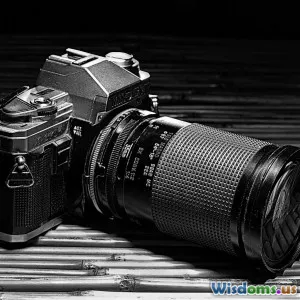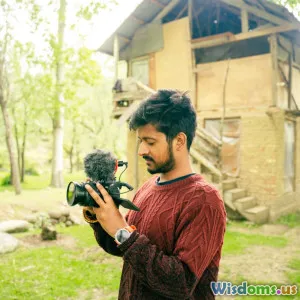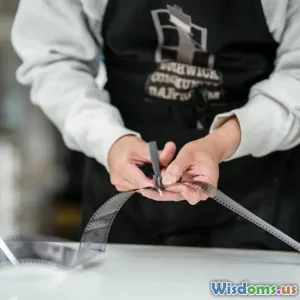
Capturing Emotion Through Film
7 min read Explore how filmmakers capture raw emotions to create unforgettable cinematic experiences. (0 Reviews)
Capturing Emotion Through Film: The Art of Storytelling Beyond Words
Emotion is the heartbeat of film – it bridges the gap between the screen and the viewer's soul. But how do filmmakers translate fleeting feelings into enduring cinematic moments? Capturing emotion through film requires a thoughtful blend of visual storytelling, nuanced performances, and technical mastery. In this article, we unravel the layers behind emotional filmmaking, offering practitioners and enthusiasts keen insights into crafting films that truly move audiences.
The Power of Emotion in Cinema
Emotion is what differentiates a moving film from a forgettable one. According to psychologist Paul Ekman, humans universally recognize six basic emotions—happiness, sadness, fear, disgust, anger, and surprise. Filmmakers harness these emotional archetypes to create connections with viewers. Take, for instance, the poignant rawness in Alfonso Cuarón's "Roma," where silent despair and subtle joy emerge through intimate camera work, drawing viewers deeply into the protagonist’s world.
How do filmmakers achieve such moments? It's a confluence of elements working in harmony: direction, acting, cinematography, sound design, and editing.
Visual Language: Lighting and Cinematography
Using Lighting to Set Mood
Lighting shapes the emotional tone immediately. Soft, diffused lighting can evoke nostalgia or vulnerability – as seen in Wong Kar-wai's "In the Mood for Love," where warm hues and shadows underscore unspoken longing.
Conversely, harsh, high-contrast lighting is often used to express tension or inner turmoil, famously employed in film noirs like "Double Indemnity." Cinematographer Roger Deakins’ use of natural light in "1917" immerses viewers in the protagonist's anxiety and exhaustion, demonstrating the power of thoughtful lighting choices.
Camera Movement and Framing
How a shot is composed and moves reflects characters’ emotions. Close-ups amplify subtle expressions; the trembling lip or quivering eye can evoke empathy with minimal dialogue. Director Ingmar Bergman excelled at close-ups, making the audience witness characters' internal struggles.
Tracking shots following characters can mirror their emotional journey. For instance, the steadicam shots in "The Shining" create a creeping suspense that audiences physically feel. Wide shots isolating a character in a vast environment communicate loneliness or despair.
Acting: The Emotional Core
No amount of technical prowess can compensate for lackluster performances. Actors breathe life and authenticity into emotions. Legendary actors like Meryl Streep or Daniel Day-Lewis are renowned for immersive preparation, accessing deep internal feelings.
Subtext and Nuance
Great performances often rely on subtext—the unspoken emotions behind words. A slight glance or hesitation can convey heartbreak, fear, or hope, building layers beyond the script.
In "Blue Valentine," Michelle Williams and Ryan Gosling’s restrained yet intense performances offer a heartbreaking portrayal of fractured love, enhanced by improvised moments that add raw intensity.
Directing for Emotion
Filmmakers guide actors emotionally during takes, creating a space for vulnerability. Director David Fincher — known for repeatedly shooting scenes to capture spontaneous performances — emphasizes collaboration to reveal truthful emotions on camera.
Editing and Sound Design: Crafting Emotional Rhythm
Editorial Pacing
Editing rhythms influence emotional engagement. Rapid cuts can heighten anxiety or excitement, seen in action thrillers like "Mad Max: Fury Road." Slower pacing allows emotional beats to settle, intensifying moments of grief or reflection, as often used in dramas like "Manchester by the Sea."
Soundscapes and Music
Sound amplifies emotions subliminally. Composer Hans Zimmer’s stirring score for "Interstellar" evokes hope amid despair, supporting the film’s emotional weight.
Ambient sounds—from a heart beating to distant rain—can ground scenes in palpable emotion, offering sensory intimacy. Strategic silence, such as in "A Quiet Place," builds tension and makes audiences listen closely to the characters’ vulnerability.
Real-World Insight: Filmmakers' Approaches
- Greta Gerwig captures youthful emotion through naturalistic dialogue and handheld camerawork, as in "Lady Bird," creating relatable, intimate moments.
- Barry Jenkins uses rich color palettes and fluid cinematography to evoke joy and pain simultaneously, exemplified in "Moonlight."
Research by the University of Glasgow in 2016 found that viewers’ emotional response increases empathy and social bonding when engaging with character-driven narratives, validating the filmmaker’s challenge to evoke authentic emotion.
Tips for Aspiring Filmmakers
- Focus on Character Depth: Create emotionally rich characters with clear motivations and flaws.
- Use Visual Metaphors: Visual symbols (like shadows, reflections) can amplify underlying emotions without exposition.
- Collaborate Closely with Actors: Develop trust to explore emotional vulnerability on screen.
- Experiment with Lighting and Color: Use color theory to reflect emotional states.
- Be Mindful of Pacing: Let the film breathe during emotional scenes.
Conclusion
Capturing emotion through film is both an art and a science. It requires combining technical skill with profound human understanding. When a filmmaker succeeds, the audience doesn’t just watch — they feel. Films like "Schindler's List," "Pan's Labyrinth," and recent gems like "Nomadland" linger long after the credits roll because they resonate emotionally.
By mastering visual storytelling, collaboration, and emotional nuance, filmmakers can harness the true power of cinema: to connect hearts, tell timeless stories, and inspire change.
Emotions woven into film are not mere embellishments but the core of compelling storytelling. As you embark on your filmmaking journey, remember: to move an audience, don’t just show them a story—make them live it.
Rate the Post
User Reviews
Popular Posts



















